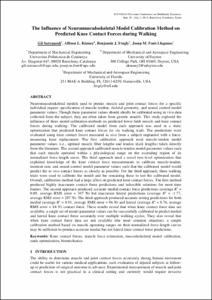Mostra el registre d'ítem simple
The influence of neuromusculoskeletal model calibration method on predicted knee contact forces during walking
| dc.contributor.author | Serrancolí, Gil |
| dc.contributor.author | Kinney, Allison L. |
| dc.contributor.author | Fregly, Benjamin J. |
| dc.contributor.author | Font Llagunes, Josep Maria |
| dc.contributor.other | Universitat Politècnica de Catalunya. Departament d'Enginyeria Mecànica |
| dc.date.accessioned | 2016-01-25T14:59:56Z |
| dc.date.available | 2016-01-25T14:59:56Z |
| dc.date.issued | 2015 |
| dc.identifier.citation | Serrancoli, G., Kinney, A.L., Fregly, B.J., Font-Llagunes, J.M. The influence of neuromusculoskeletal model calibration method on predicted knee contact forces during walking. A: ECCOMAS Thematic Conference on Multibody Dynamics. "Proceedings of the ECCOMAS Thematic Conference on Multibody Dynamics 2015". Barcelona: Centre Internacional de Mètodes Numèrics en Enginyeria (CIMNE), 2015, p. 1068-1079. |
| dc.identifier.isbn | 978-84-944244-0-3 |
| dc.identifier.uri | http://hdl.handle.net/2117/81984 |
| dc.description.abstract | Neuromusculoskeletal models used to predict muscle and joint contact forces for a specific individual require specification of muscle-tendon, skeletal geometry, and neural control model parameter values. Though these parameter values should ideally be calibrated using in vivo data collected from the subject, they are often taken from generic models. This study explored the influence of three model calibration methods on predicted lower limb muscle and knee contact forces during walking. The calibrated model from each approach was used in a static optimization that predicted knee contact forces for six walking trials. The predictions were evaluated using knee contact forces measured in vivo from a subject implanted with a force-measuring knee replacement. The first calibration approach used muscle-tendon model parameter values (i.e., optimal muscle fiber lengths and tendon slack lengths) taken directly from the literature. The second approach calibrated muscle-tendon model parameter values such that each muscle operated within a physiological range on the ascending region of its normalized force-length curve. The third approach used a novel two-level optimization that exploited knowledge of the knee contact force measurements to calibrate muscle-tendon, moment arm, and neural control model parameter values such that the calibrated model would predict the in vivo contact forces as closely as possible. For the third approach, three walking trials were used to calibrate the model and the remaining three to test the calibrated model. Overall, calibration method had a large affect on predicted knee contact forces. The first method produced highly inaccurate contact force predictions and infeasible solutions for most time frames. The second approach produced accurate medial contact force predictions (average R2 = 0.89, average RMS error = 107 N) but inaccurate lateral predictions (average R2 = -1.77, average RMS error = 297 N). The third approach produced accurate testing predictions for both medial (average R2 = 0.91, average RMS error = 96 N) and lateral (average R2 = 0.76, average RMS error = 84 N) contact force. These results reveal that when knee contact force data are available, a single set of model parameter values can be successfully calibrated to predict medial and lateral knee contact force accurately over multiple walking cycles. They also reveal that when knee contact force data are not available (the most common situation), a simple calibration method based on muscle operating ranges on their normalized force-length curves may be sufficient to produce accurate medial but not lateral knee contact force predictions. |
| dc.format.extent | 12 p. |
| dc.language.iso | eng |
| dc.publisher | Centre Internacional de Mètodes Numèrics en Enginyeria (CIMNE) |
| dc.rights.uri | http://creativecommons.org/licenses/by-nc-nd/3.0/es/ |
| dc.subject | Àrees temàtiques de la UPC::Enginyeria mecànica |
| dc.subject | Àrees temàtiques de la UPC::Enginyeria biomèdica::Biomecànica |
| dc.subject.lcsh | Biomechanics |
| dc.subject.lcsh | Calibration |
| dc.subject.lcsh | Knee |
| dc.subject.other | Knee contact forces |
| dc.subject.other | Muscle force estimation |
| dc.subject.other | Musculoskeletal model calibration |
| dc.subject.other | Static optimization |
| dc.subject.other | Biomechanics |
| dc.title | The influence of neuromusculoskeletal model calibration method on predicted knee contact forces during walking |
| dc.type | Conference report |
| dc.subject.lemac | Biomecànica |
| dc.subject.lemac | Calibratge |
| dc.subject.lemac | Genolls |
| dc.contributor.group | Universitat Politècnica de Catalunya. BIOMEC - Biomechanical Engineering Lab |
| dc.relation.publisherversion | http://www.multibody2015.org/frontal/img/Ebook_Multibody_2015.pdf |
| dc.rights.access | Open Access |
| local.identifier.drac | 16980254 |
| dc.description.version | Postprint (published version) |
| local.citation.author | Serrancoli, G.; Kinney, A.L.; Fregly, B.J.; Font-Llagunes, J.M. |
| local.citation.contributor | ECCOMAS Thematic Conference on Multibody Dynamics |
| local.citation.pubplace | Barcelona |
| local.citation.publicationName | Proceedings of the ECCOMAS Thematic Conference on Multibody Dynamics 2015 |
| local.citation.startingPage | 1068 |
| local.citation.endingPage | 1079 |


